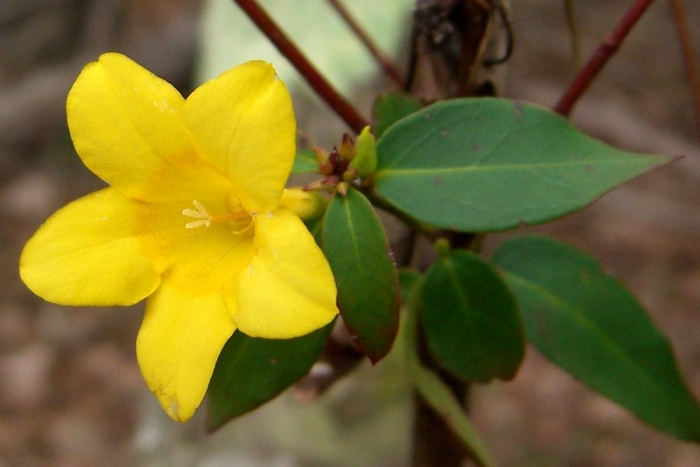Rankin’s Trumpetflower
(Gelsemium rankinii)
Rankin’s Trumpetflower (Gelsemium rankinii)
/
/

Jason Hollinger
CC BY 2.0
Image By:
Jason Hollinger
Recorded By:
Copyright:
CC BY 2.0
Copyright Notice:
Photo by: Jason Hollinger | License Type: CC BY 2.0 | License URL: https://creativecommons.org/licenses/by/2.0 | Uploader: File Upload Bot (Magnus Manske) | Publisher: Wikimedia Commons | Title: Swamp_Jessamine_(993733505).jpg | Notes: {{BotMoveToCommons|de.wikipedia}} {{Information |Description={{de|Japanischer Herbstenzian (Gentiana scabra)}} |Source=Transferred from [http://de.wikipedia.org de.wikipedia]; transferred to Commons by [[User:Daniel_1992]] using [http://too
























































Estimated Native Range
Summary
Gelsemium rankinii, commonly known as Rankin’s Trumpetflower, is a semi-deciduous perennial vine native to the coastal plains, woodlands, and scrublands of the Southeastern United States. It can climb to heights of 15-20 feet (5-6 meters) with a spread of 10-15 feet (3-4.6 meters). This vine is characterized by its twining habit and lanceolate leaves. It produces showy, funnel-shaped yellow flowers that are particularly abundant in the spring and sporadically bloom in the fall, attracting pollinators such as bees and butterflies.
Rankin’s Trumpetflower is valued for its ornamental flowers and ability to cover structures quickly, making it suitable for trellises, fences, and as a natural screen. It is relatively low-maintenance, requiring only occasional pruning to control its spread. In cultivation, it thrives in full sun to part shade and prefers well-drained soils, though it can tolerate a range of soil types. While generally pest-free, it can be susceptible to aphids and mealybugs. Gardeners should be cautious as all parts of the plant are toxic if ingested.CC BY-SA 4.0
Rankin’s Trumpetflower is valued for its ornamental flowers and ability to cover structures quickly, making it suitable for trellises, fences, and as a natural screen. It is relatively low-maintenance, requiring only occasional pruning to control its spread. In cultivation, it thrives in full sun to part shade and prefers well-drained soils, though it can tolerate a range of soil types. While generally pest-free, it can be susceptible to aphids and mealybugs. Gardeners should be cautious as all parts of the plant are toxic if ingested.CC BY-SA 4.0
Plant Description
- Plant Type: Vine
- Height: 15-20 feet
- Width: 10-15 feet
- Growth Rate: Rapid
- Flower Color: Yellow
- Flowering Season: Fall, Spring
- Leaf Retention: Semi-Deciduous
Growth Requirements
- Sun: Full Sun, Part Shade
- Water: Medium
- Drainage: Medium
Common Uses
Bee Garden, Bird Garden, Butterfly Garden, Deer Resistant, Fragrant, Groundcover, Hummingbird Garden, Low Maintenance, Showy Flowers, Water Garden
Natural Habitat
Coastal plains, woodlands, and scrublands
Other Names
Common Names: Swamp Jessamine
Scientific Names: , Gelsemium rankinii, Gelsemium sempervirens var. inodorum,
GBIF Accepted Name: Gelsemium rankinii Small